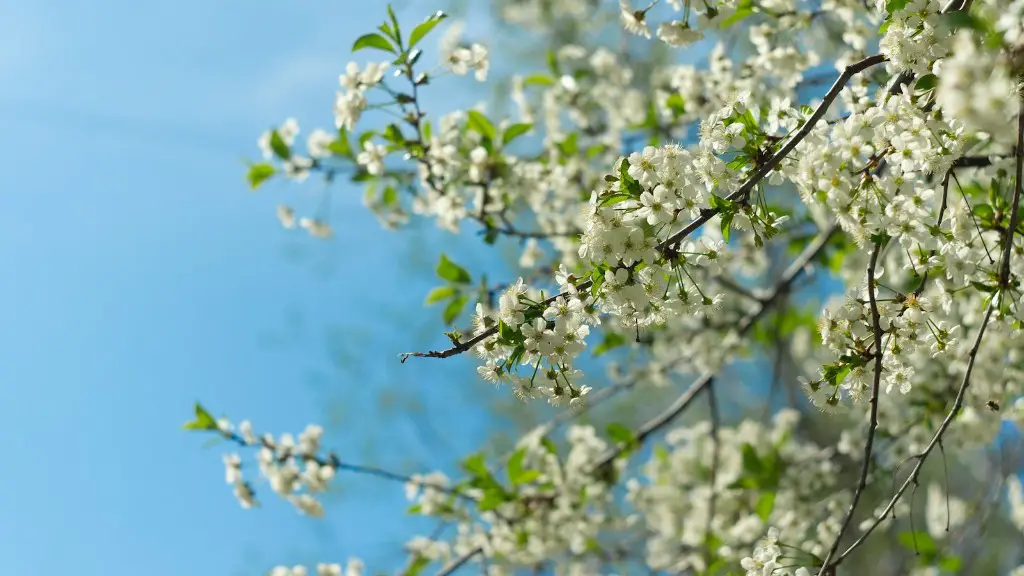Pruning a honeycrisp apple tree is an important part of maintaining a healthy and productive tree. Proper pruning techniques can be used to ensure the tree grows strong and produces quality apples. This article provides tips and advice on pruning your honeycrisp apple tree correctly.
When pruning your honeycrisp apple tree, it’s important to bear in mind that the goal of pruning is to balance between too much growth and too little growth. Too much growth is more susceptible to disease and pests and it can be difficult to manage. Too little growth can stunt the tree’s growth and reduce yields.
The best time to prune your honeycrisp apple tree is in the late winter or early spring, when the tree is still in its dormant stage. It’s important to remove any dead, diseased, or broken branches as soon as possible. You should also remove any branches that are crossing over each other or growing inwards, as these can interfere with the apple tree’s effective growth.
When pruning, it’s important to use the appropriate tools. A hand pruner is the best tool for pruning small branches, while a lopper or pruning saw is better suited for thicker branches. It’s also a good idea to use a pair of gloves to protect your hands against cuts and scrapes.
Additionally, when trimming your apple tree, it’s important to ensure only the specified branches are trimmed. Aim to remove no more than 1/3 of the tree’s foliage during pruning, as too much pruning can cause undue stress to the tree. Make sure to cut the branches off cleanly and away from the trunk to promote healthy new growth.
Finally, once you’ve pruned your honeycrisp apple tree, it’s important to properly dispose of the clippings. Cuttings can introduce pests and diseases back into your tree, so it’s important to either burn or throw away the clippings. Additionally, topping off your tree can also help prevent insect infestations, as it reduces the likelihood of pests looking for a place to lay eggs.
Methods Of Pruning
Pruning your honeycrisp apple tree doesn’t need to be complicated – there are a few different methods for pruning which can all provide effective results. One common method is the ‘topiary’ method, where you trim back any excess shoots and shape the tree up into a more pleasing aesthetic form. This is a good method if you’re looking to tidy up the look of your apple tree or if you’re pruning for a specific purpose, such as fruit production.
The ‘central leader’ method is also a great choice for pruning honeycrisp apple trees. This method requires you to prune any excess shoots away from the central stem and encourages the tree to grow upward – this method is especially effective for young trees, and helps promote a strong and healthy upright growth.
The ‘open center’ method of pruning apples is also a popular one. This requires you to prune away any excess shoots and branches that are growing inwards and creating a cluttered canopy. This helps to ensure any fruit that is produced is of a better quality and that the tree is less susceptible to diseases and pests.
Another popular method is ‘renewal pruning’. With this method, you focus on removing the oldest branches from the base of the tree and encouraging new growth from the stem. This is a great method for keeping your apple tree healthy and productive, as it encourages new growth and can even help invigorate a tree that has seen better days.
The ‘structural pruning’ method is also a good choice for honeycrisp apple trees. This largely involves removing any excess shoots and branches that interfere with or cause damage to the other parts of the tree. This helps to ensure the tree is structurally sound and healthy, and better able to handle any adverse weather conditions.
Limiting Pruning
In addition to pruning properly, it’s also important to ensure you limit the amount of pruning you do to your honeycrisp apple tree. Pruning too much can cause stress to the tree, and can even lead to excessive growth, which can increase the risk of diseases and pests. Limiting pruning should be done by avoiding topping or ‘lion’s tailing’, which can reduce the canopy of the tree and lead to a disproportionate shape.
It’s also important to leave ‘fruiting’ and ‘leader’ branches alone. Fruiting branches are the branches that have already produced apples in the past and should ideally be left untouched, as they are integral to the amount of apples produced. Leader branches are the first branches to grow in the spring, and these should also be left alone, as they contribute to the tree’s overall health.
Pruning can be a great way to keep your honeycrisp apple tree healthy and productive. By following these tips and advice, you can ensure you’re pruning your tree correctly, as well as limiting pruning to ensure the tree remains productive and healthy.
Wounds and Cuts
In addition to the pruning tips and advice described above, it’s also important to consider how to address any wounds or cuts made during the pruning process. During pruning, it’s inevitable that some stems and branches will be cut off, and it’s important to ensure these stubs and wounds are treated properly to avoid problems.
It’s important not to leave stubs, as these can attract disease and pests. It’s best to cut off any stubs as cleanly and as close to the bark as possible. Additionally, it’s important to coat any cuts with a tree healing sealant. Tree healing sealants can help stop any wounds or cuts from attracting pests, as well as diseases and fungal growth.
Tree wound dressing shouldn’t be used on apple trees, as this can slow down the healing process. If a wound does become infected, it’s important to take steps to treat the infection, such as pruning away the infected areas and applying a fungicide. It’s also a good idea to keep an eye out for any branches or stems that appear to be affected by diseases, as early detection is key to avoiding a bigger problem.
In summary, pruning your honeycrisp apple tree is an important part of ensuring it remains healthy and productive. Taking the time to prune the tree correctly and address any wounds or cuts made during the process will help ensure your tree remains productive and healthy, and that you get good apple harvests in the future.
Pruning Strategies
There are many different strategies when it comes to pruning your honeycrisp apple tree. One of these strategies is to start pruning while the tree is still relatively young, as this will help promote strong, healthy growth. Additionally, it’s important to keep an eye out for any diseased branches, as these should be pruned off right away.
It’s also important to focus on removing any branches or shoots that are growing inwards or crossing over each other – these can interfere with the tree’s growth and should be removed as soon as possible. It’s also a good idea to prune off any water sprouts or hedge shears, as these can drain away the tree’s energy.
When it comes to thinning out the canopy of the tree, it’s important to follow a specific method. Thinning out the canopy of an apple tree helps improve air circulation, which helps reduce the chances of fungal growth and disease. It’s important to thin out in layers, starting from the outside and working inwards.
It’s also important to leave enough foliage on the tree to ensure it’s healthy and productive. Aim to remove no more than 1/3 of the total foliage in any pruning session, as too much pruning can lead to excessive growth and hamper the tree’s productivity. Additionally, you should ensure you don’t prune too late in the season, as this can affect the tree’s natural dormancy period.
Finally, when pruning your apple tree, it’s important to avoid pruning too much away from the central stem. This can cause an imbalance in the tree’s structure, which can lead to weak growth and poor yields. Instead, focus on removing any excess shoots and branches, but leave the main branches intact.
Maintenance
Maintaining your honeycrisp apple tree is also an important part of having a healthy and productive tree. After pruning, it’s important to maintain the tree on a regular basis. This includes feeding the soil, fertilizing the tree, and checking for any pests or diseases.
It’s important to feed the soil of your apple tree on a regular basis, as this helps promote healthy growth and helps ensure the tree’s nutritional needs are met. Additionally, it’s important to fertilize the tree on a regular basis – this helps promote good root and shoot growth, as well as increasing the amount of apples the tree will produce.
Finally, it’s important to keep an eye out for any pests or diseases. If you spot any pests or signs of disease, it’s important to take action right away. Common pests and diseases to look out for include aphids, fire blight, and cedar rust, as these can all cause significant damage to your apple tree.
In summary, pruning your honeycrisp apple tree is an important part of maintaining a healthy and productive tree. By following the tips and advice outlined in this article, you can ensure you’re pruning correctly and helping to maintain the health of your apple tree. The addition of maintenance practices, such as fertilizing and pest control, can also help to ensure your apple tree remains robust and productive.



